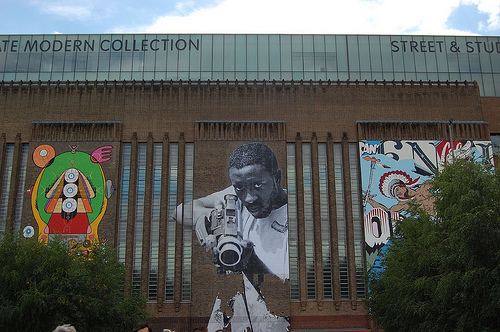The Tate Modern
The Tate Modern has an imposing position opposite St. Paul’s Cathedral along the Thames River and is situated within a converted power station. It is free to the public and the modern art displays change quite frequently. Immediately outside is the Millennium Bridge.
Britain’s national museum of international modern art is known as the Tate Modern and is, with Tate Online, Tate St. Ives, Tate Liverpool, and Tate Britain are simply known as Tate.

The Tate galleries are housed in the former Bankside Power Station, which was built in two stages between 1947 and 1963 and was originally designed by Sir Giles Gilbert. The power station closed in 1981. The building was converted by architects de Meuron and Herzog, after which it stood at 99 m tall. The southern third of the building was retained by the French power company EDF Energy as an electrical substation.
The collections in Tate Modern are made up of international contemporary and modern art works dating from as far back as 1900 and continuing forward to present day. The Tate Collection is displayed on levels five and three of the building, while level two houses a small exhibition space with work by contemporary artists and level four houses large temporary exhibitions.
The collections were not displayed in chronological order when the gallery opened in 2000 but rather were arranged thematically into four broad groups: Still life/Object/Real Life; Landscape/Matter/Environment; Nude/Action/Body, and; History/Memory/Society. The first rehang at Tate Modern opened in May 2006. It eschewed the thematic groupings in favor of focusing on pivotal moments of twentieth century art, with further spaces allocated on levels 3 and 5 for shorter exhibitions. The layout is: Level 3, Material Gestures; This focuses on abstract expressionism, expressionism and, abstraction and features work by Tacita Dean, Henri Matisse, Mark Rothko, Barnett Newman, Anish Kapoor, and Claude Monet.
Section four focuses on Arte Povera, with work by artists such as Jenny Holzer, Mario Merz, Ana Mendieta, Kasimir, Jannis Kounellis, and Alighiero Boetti.
Section five focuses on Pop Art, Vorticism, Futurism, and Cubism and contains work by artists such as Andy Warhol. Roy Lichtenstein, Pablo Picasso and photographer Eugene Atget,
The Turbine Hall, which once housed the electricity generators of the old power station, is five storeys tall and has 3,400 square meters of floorspace. Between October and March each year it is utilized to display works by contemporary artists in a series which is sponsored by Unilever. This series was planned to last the gallery’s first five years, but the popularity of the series has led to its extension until at least 2012.
The artists that have exhibited commissioned work in the turbine hall are: Louise Bourgeois, Maman: Juan Munoz, Double Bind; Anish Kapoor, Marsyas; Olafur Eliasson, The Weather Project; Bruce Nauman, Raw Materials; Rachel Whiteread, Embankment; Carsten Holler, Test Site; Doris Salcedo, Shibboleth; Doninique Gonzalez-Foerster, TH.2058, and; Miroslaw Balka, How It Is
The Level 2 Gallery is a smaller gallery located on the north side of the building and houses exhibitions of cutting edge contemporary art. Its exhibitions normally run for 2 to 3 months.
Level 4 is broken into two large exhibition areas as are levels 3 and 5. An entry fee is charged since this is used to stage the major temporary exhibitions. These exhibitions normally run for three or four months. The two exhibition areas are sometimes combined to host a single exhibition.
Temporary small exhibition spaces are also located between the two galleries on levels 3 and 5. These may be used to display recent acquisitions. Works are also sometimes shown in the restaurants and members’ room. Other locations that have been used in the past include the north facing exterior of the building and the mezzanine on Level 2
To the west of Tate Modern lie Sampson House, a massive late Britalist office building and the sleek stone and glass Ludgate House, the former headquarters of Express Newspapers.
Tate Modern has attracted more visitors than originally expected and plans to expand it have been in preparation for some time. These plans have focused on three areas for expansion all to the south of the building: The area no longer required by EDF Energy; Three large, unused, underground oil tanks which were originally used by the power station, and; A major new extension building to be built above the oil drums.
The design of the new extension building, also designed by de Meuron and Herzog, has been controversial. It was originally designed as a glass stepped pyramid, however, this has recently been changed to incorporate a brick sloping façade after feedback on the original design was negative. The extension will include galleries dedicated to exhibitions, video, photography, and the community. This project will cost approximately £215 million and is scheduled to open in 2012, in time for the 2012 Olympic Games being held in the city. Additionally, the Tate Britain will be undergoing refurbishment.

